Goji Berry Plant Guide. How to EVERYTHING Goji Berry
Goji Berry (Wolfberry) health benefits are well publicized but did you know Goji plants grows like weeds! Well, they grow more like a spindly, open shrubs. And, did you know there are THREE different varieties of Goji?!?!
ONLY THREE species of Goji Berries are consumed as medicine and food in China; however, there are 80 species of Lycium L. in the world. Red Goji (Lycium barbarum) is the variety sold in North America. Asian markets will include the other two species (Black & Chinese Goji Berry).
Three Goji Berry plant species are:
- Black Goji Berry (Lycium ruthenicum)
- Chinese Goji Berry (Lycium chinense), and the
- Red and Golden Goji Berry (Lycium barbarum).
All Goji Berry plants are self-fertile, pest and disease free, drought tolerant, and forgiving (easy-to-grow). Trellis Goji Berry plants, prune so they grow like a bush or grow them with a single trunk. Select a type of Goji Berry and a plant-care technique based on your goals! It’s up to YOU!
Did you know that the Black Goji Berry tea has 5 times more antioxidant capacity and 2 times more polyphenols (micronutrients that naturally occur in plants) versus Red Goji Berry tea. Also, the Golden Goji Berry (Lycium barbarum) is jucier and not bitter versus the Red Goji.
But do NOT get caught-up on the Goji hype. i reviewed 15+ clinical studies to write about Goji Berry health benefits. Goji Berries provide dietary fiber, vitamin C, minerals, healthy fatty acids, amino acids, antioxidants, and polyphenols. However, I don’t see evidence for calling it a “superfruit”. Unfortunately, there IS evidence of people committing fraud by making crazy health claims. BE cautious.
Red Goji (Lycium barbarum) are almost always sold dried; however, did you know that sun drying the fruit destroys some valuable nutrients? And…that some Goji products are sold with insecticide and fungicide residues? BE cautious. If possible, buy freeze dried Goji that are organically grown.
Bottom-line: we will eat the Goji Berries we grow, and will sell Goji plants. However, we will not give Goji Berry a ‘superfruit’ status, given the evidence. HEPPY™ is a no-bull$#it family, and ‘call it like we see it’ 😉
This Goji Berry Plant Guide explains EVERYTHING Goji on ONE ad-free webpage. Know it, grow it, eat it, or sell it! Welcome to HEPPY™!

Goji Berry Plant Guide on ONE ad-free webpage!
On this page:
1. Goji Berry Fact Sheet
2. Types of Goji Berry Plants
3. Goji Berry in landscaping and garden ideas.
4. How to Eat Goji Berry.
5. Goji Berry health benefits.
6. Commercial uses and opportunity.
7. Goji Berry Plant Guide for Care and Maintenance.
8. Propagating Goji Berry.
9. Varieties that we grow organically right now!
________________________________________
see our list of 400 edible plants
YouTube channel (please subscribe)
YouTube playlist for Goji Berry (please subscribe)
Goji Berry Fact Sheet
common names: Wolfberry, and MANY more. See 3 Types of Goji Berry.
Zone: 3 to 10 (depending on cultivar; zone 7 for all Goji Berry cultivars)
Height: 6 to 8 feet
Native: no
Bloom Time: May – August
Bloom Color: Light Purple
Fruit Maturity: August – October
Self-fertile: yes
Sun: full sun to part shade
Water: medium (soil dependent)
Soil: forgiving (must drain well)
Maintenance: low
Growth Rate: moderate
Deciduous or evergreen: deciduous
Edible¹: yes
Medicinal²: yes
Commercial viability: strong
Family / Genus (species): Solanaceae / Lycium (Lycium ruthenicum, Lycium chinense and Lycium barbarum)
Remarks:

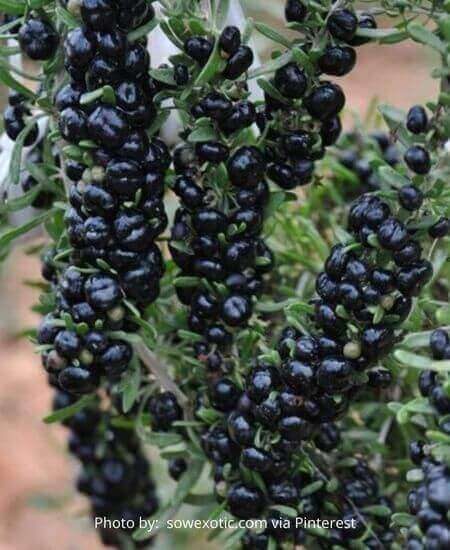

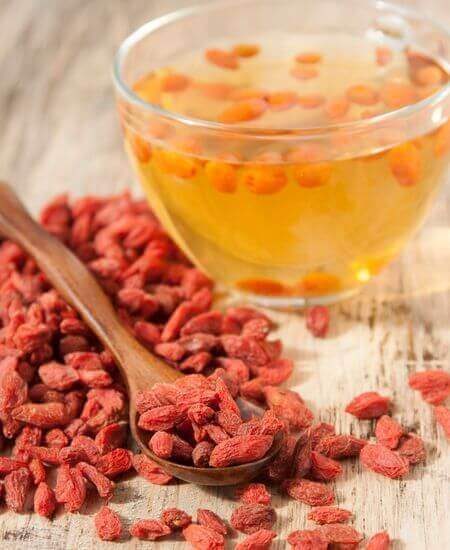
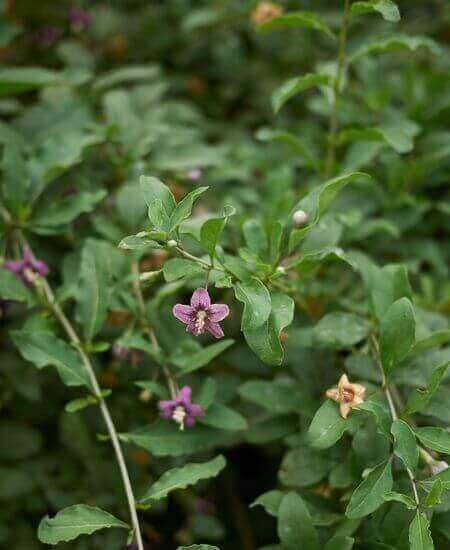
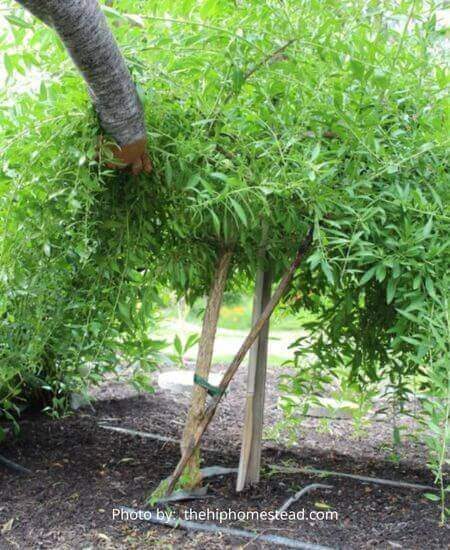
3 Types of Goji Berry — Black, Chinese and Red
three Goji species are
- Black Goji (Lycium ruthenicum),
- Chinese Goji (Lycium chinense), and
- Golden & Red Gojis (Lycium barbarum).
in North American, the Black and Chinese Goji Berries are rarely grown. The Red Goji Berry Lycium barbarum is commonly grown; however, the Golden Goji Berry is also rarely grown.
all three Goji Berry species are self-fertile, heat and cold tolerant, and tolerate poor soils but prefer well draining soil. all three species sucker (roots spread underground and new growth sprouts-up from the soil). all have lilac or lavender colored flowers, and are largely pest and disease free! ‘thorns’ are reported but the number of thorns seems to vary among the 3 Goji Berry species.
Black Goji (Lycium ruthenicum)
Lycium ruthenicum common names include the Russian Box Thorn or Black Wolfberry, this species is native to from the Caucasus, Turkey and Iran through Mongolia and Tibet. it grows native in elevations from 1,000 feet (400+ m) to nearly 10,000 feet (3,000 m).
Black Goji plants tolerate drought, maritime exposure and saline soils. in fact, Black Goji is “highly suitable for combating soil desertification and alleviating soil salinity/alkalinity/pollution….” it suckers quickly. Black Goji Berry have extensive root systems, and can be planted to stabilize banks and sandy soils.
this plant thrives in full sun. also, it appears to have ‘healthy’ thorns. the Black Goji Berry at planted HEPPY™ are not thorny. it’s “leaves” remind me of the Rosemary. compact ‘leaves’ with a light gray to greenish color. Lycium ruthenicum leaves are very different to the Lycium chinense and Lycium barbarum. lilac colored flowers develop into green berries that turn purple and eventually, into black berries when ripe.
the Black Goji is adapted to USDA zones 5-10, and grows compact from 4 to 8 feet in height. i cannot find named cultivars.
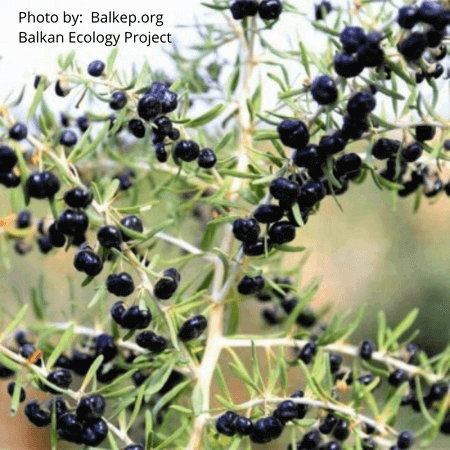
Chinese Goji (Lycium chinense)
Lycium chinense common names include the Chinese Boxthorn, Chinese Desert-thorn, Chinese matrimony-vine, Chinese Teaplant, and Chinese Wolfberry. it is native to China, Taiwan and Japan.
Chinese Goji Berry is a major Chinese tonic herb with a history of almost 2,000 years of medicinal use. young leaves are used fresh in salad, stir-fried or in soup. the fruit is cooked in soups or dried for later use. Chinese Goji Berry fruit has a sweet, licorice flavor or aniseed-like flavor.
it has few, if any, thorns. this species looks and grows like the Red/Golden Goji Berry, Lycium barbarum. lilac or purple colored flowers develop into green berries that evolve to a bright red berry when ripe. sprawling branches grows to 3 to 6 feet long. trellis this species to keep the ends-of-branches out of the soil. this shrub will naturalize by self seeding (sometimes aggressively) and by suckering. as with the Black Goji Berry, this species is an ideal plant for erosion control.
the Chinese Goji is adapted to USDA zones 6-9, and grows open, weeping branches 3 to 6 feet tall, and can spread it’s arching branches up to 10 feet from the base. i cannot find named cultivars.
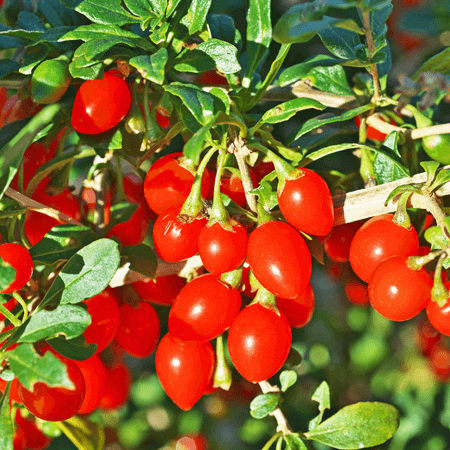
Golden & Red (Lycium barbarum)
Lycium barbarum common names include the Box Thorn, Boxthorn Fruit, Goji, Gǒuqǐ, Gouqizi, Matrimony Vine and Wolfberry (Wolf Berry). it is ~native~ across Asia and southeast Europe.
this is the variety sold commercially in North American markets. dehydrated Red Goji Berries is the common product; some US markets sell them fresh. it was difficult to find reliable data on production. my research found that China supplies much of the market.
Lycium barbarum produce either golden or red colored fruit. HEPPY™ grows the Golden and Phoenix Tears cultivars. below, we describe our experience with all Goji Berry cultivars.
this species is hardy to zone 5! however, the Phoenix Tears cultivar is hardy to zone 3. it grows in full to half-day sun. as an experiment, we have one Lycium barbarum in nearly full shade. she’s growing well.
GOLDEN Goji Berry (Lycium barbarum)
in 2017, the Golden Goji Berry was developed by the Ningxia Academy of Agricultural Sciences. 12 strains were reduced to 4 and then, two new cultivars emerged, named “Ning Nongqi No. 4” and “Ning Nongqi No. 5”.
the ‘Golden’ Goji is the cultivar sold in States; ‘Amber Sweet’ and ‘Golden Jewel’ are other cultivars sold in Europe and Canada.
Golden Goji Berry plants produce gold-yellow colored fruit. compared with the fruits of the Red Goji Berry, Golden Goji fruit juice has no smell, no bitterness, and delicate flesh. Golden Goji Berry juice rate reached more than 80%, while red goji berry is only 67.5%. it is CLAIMED but unverified that total flavonoids in the Golden Goji fruit is more than 0.83 mg, 60% higher than the red goji berry.
HEPPY™ predicts that taste alone will make the Golden Goji more popular. that’s why we purchase three plants!
RED Goji Berry (Lycium barbarum)
the ‘Phoenix Tears’, ‘Red Empress’ and ‘Crimson Star’ (Ning-qi No. 1) are cultivars produce red fruit. ‘Sweet Lifeberry’ is a proprietary cultivar, and ‘Sask Wolfberry’ is a Canadian cultivar. these cultivars are found throughout North American nurseries. ‘Erma’ and ‘Biglifeberry’ found in Europe (perhaps NA too).
China is the main supplier of Goji food products in the world. however, i cannot find clear data (total Goji grown; % grown in China).
Reb Goji (Lycium barbarum) IS the fruit you buy online and in stores. it’s the species most heavily researched and consumed. HEPPY grows the Phoenix Tears cultivar. it’s a vigorous growing and good producing plant!

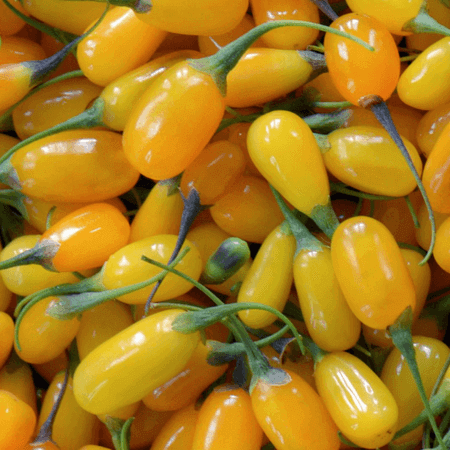
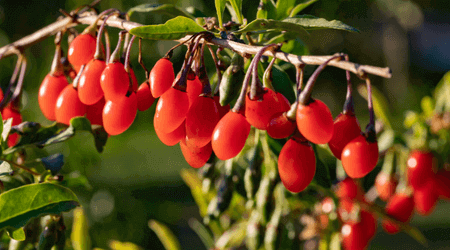
Goji Berry in landscaping and garden ideas
Goji plants are GENERALLY not visually appealing. they typically grow open, with 5 to 7 sprawling branches growing from the plant’s base. there are exceptions; in the right location, and with regular pruning, they may look as nice as The Hip Homestead’s Goji Berry plants.
Landscape Architecture
in landscape architecture, Goji plants best suited for along a fence where the plants gets plenty of sunlight. alternatively, grow the Goji plant as an exhibition plant.
Goji plants are well suited for dry sandy banks or slopes, and where erosion control is needed. these plants sucker. they grow as a VERY open ~bush; 5 to 7 sprawling branches growing from the plant’s base. however, i see commercial and home gardeners growing Goji Berry plants as single stemmed plants. this is new to HEPPY™ (May 2022). we will begin growing some specimens this way! please subscribe to our YouTube Channel and follow us as we experiment & learn new landscape architecture techniques.
planting a Black, Golden and Red together would be an interesting, novel idea.
caution: many varieties are slightly thorny. the ‘thorns’ are not cactus-like; they are hardened dry
Garden Ideas
be prepared to trellis the Goji Berry plant if you’re growing it for fruit. it is common for the tips of arching branches to touch soil. fruit rubbing the soil are low quality.
although drought tolerant, the Lycium barbarum species appreciate a good watering when it get’s hot and dry. they do not like ‘wet feet’ so don’t over water.
Goji Berry are disease/pest free so NO spray or chemicals are needed. also, Black Goji is “highly suitable for combating soil desertification and alleviating soil salinity/alkalinity/pollution….“
we grow our plants in high organic soil. however, they tolerate many types soils, including infertile soil.

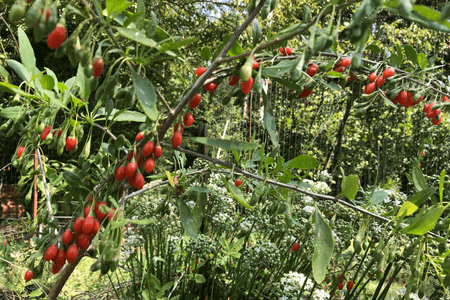
How to Eat Goji Berry
1, 2 HEPPY cannot take any responsibility for any adverse effects from the use of plants. Always seek advice from a professional before using a plant for food or medicinally. This information is intended for educational purposes only and should not be considered as a recommendation or an endorsement of any particular medical or health treatment.
Goji plant (fruit, roots, leaves, shoots, etc.) interactions with medications:
- avoid the combination Warfarin (Coumadin) and Goji Berry. see PubMed study, Possible interaction between warfarin and the Goji Berry plant. (avoid all species of Goji and warfarin, is our recommendation).
- see National Library of Medicine MedlinePlus interactions with medications. Major risk (Warfarin (Coumadin)); Moderate risk (Flecainide (Tambocor)); Minor risk (Medications for diabetes (Antidiabetes drugs).
- Goji Berry fruit has Atropine but likely, “far below toxic levels.” Atropine is a prescription medicine used to treat several issues to include symptoms of low heart rate (bradycardia). this study found Atropine in all examined samples, with the highest concentration at 19 ppb (i believe this is Parts Per Billion). the study concludes, “Therefore, the content is far below toxic levels.” another study cites, “Trace amounts of atropine detected in the fruit are of no toxicological relevance.”
Edible Goji Berry fruit
eat the berries as a juice, smoothies, herbal tea, powdered, fresh or dried, and in soups. Goji Berries are baked into muffins, cookies, bread, and chocolate. place them in burgers or sausage. or, add them to trail mix, oatmeal, cereal, salads, or in quinoa, rice, and other grain dishes. also, wine, liqueur and beer is made from Gojis.
flavor: it’s described as “a mild sweet licorice flavor”; “sweet with an aniseed-like flavor”.
at HEPPY™, we pick and eat fresh Phoenix Tears Goji Berries. they have a strong flavor; i describe the flavor as ‘plant.’ yes, it just tastes like plant. it has a rather strong flavor, and is slightly bitter. we eat a 1/2 cup of fruit daily while gardening. we pick berries when they’re dark red. eat fresh Goji Berries whole — seeds, skin and all.
we can’t wait to eat Golden Goji Berry fruit. 15% juicier with no bitterness vs the Red Goji Berry. that’s why we bought THREE plants! learn how to harvest as store Goji Berry below.
Goji Juice with FRESH berries
blend a 2:1 ratio, fresh Goji Berry and water.
for example, blend 2 cups fresh berries with 1 cup water. ADD a pinch of salt, and flavor with chia seeds, kale, mango, banana, strawberries, orange, or carrots. BE SURE to remove the green stems. you may choose to stain the juice through cheesecloth but drinking the plant material (blended skin, seeds) are good for YOU!
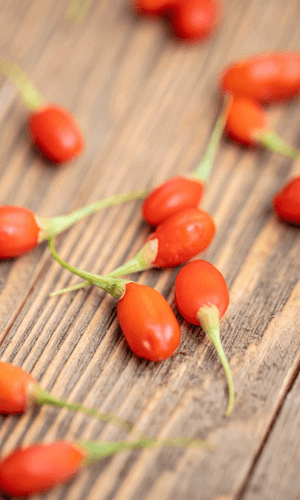
Goji Juice with DRIED berries
blend a 1/2:4 ratio, dried Goji Berry and water.
first, soak dried Goji Berries until they become plump and chewy. then, blend 1/2 cup dried berries with 4 cups of water. ADD a pinch of salt, and flavor with chia seeds, kale, mango, banana, strawberries, orange, or carrots. BE SURE to remove the green stems. you may choose to stain the juice through cheesecloth but drinking the plant material (blended skin, seeds) are good for YOU!
Dried Goji Berries: freeze drying, hot air drying, and sun drying
dry Goji Berry fruit by freeze drying (FD), hot air drying (HD) or sun drying (SD). one October 2021 study that showed that freeze drying is best. Black Goji Berry was studied. the results are likely the same for all Goji Berries (and probably, the same for all fruits. There’s a lot to explore and we invite interns and volunteers to explore scientific literature that evaluates drying methods and techniques).
FD is better than HD is better than SD. “better” is defined as MORE polyphenols (a large family of antioxidants). specifically, anthocyanin, asparagine, phenolic and procyanidin content (specific antioxidants) were the “main sources of the difference in Black Goji Berry dried by different methods.”
drying pretreatment: rinse Goji Berries in 3% solution of baking soda (Sodium bicarbonate), then wash with water.
in general, soaking fruit & veggies in baking soda is good. soaking fruit & veggies in baking soda removes or reduces pesticides.
for Goji, soaking baking soda removes or reduces the fruit’s waxy layer. the the waxy layer will block moisture removal which affects drying.
Freeze Drying Goji Berry
freeze drying preserves the most polyphenols (a large family of antioxidants) such as anthocyanin, asparagine, phenolic and procyanidin content.
commercial freeze drying is not practical for us but the standard freezer gets us close. all we have is the researcher’s freeze drying techniques, until HEPPY™ can evaluate practical ways to freeze dry fruit.
freeze Goji Berries down to -22° F (−30° C). but a standard home freezer is only 0° F (-18° C). then “the vacuum was continuously increased to 50 Pa. Finally, the temperature was gradually lowered to −60° C [-76° F] and maintained for 30 h.” let’s just hope that freezing fruit at 0° F (-18° C), and keeping fruit frozen for one, two or more weeks, gets us close to freeze dried fruit.
Hot Air Drying and Sun Drying Goji Berry
the remarks below are from a study of freeze drying, hot air drying, and sun drying Black Goji Berries. however, i believe it’s quite convoluted. too complicated. HEPPY™ WILL do a ‘deep dive’ on drying techniques: drying options and what method produces the highest quality of fruits, vegetables and herbs.
hot air drying: place Goji Berries single layer on a baking sheet, and place in a ventilated oven at 104° F (40° C) for 7 hours. then, place berries in were moved to room temperature for another 7 hours. then place fruit a drying oven at 113° F (45° C) for 4 hours. then, maintained fruit at 122° F (50° C) for 12 hours, and then 140° F (60° C) for 5 hours.
sun drying: spread Goji Berries on trays with a single layer and placed in the dark for 2 hours. then, expose drying trays to the sun at 60-90° F (20-32° C) until the skin is wrinkled. then place drying trays in the shade for approximately 10 days.
Goji Berry Recipes
Goji Berries are used fresh, dried or powdered to make smoothies, parfaits, trail mix, baked goods, oatmeal, cereal, salads, or in quinoa, rice, and other grain dishes.
here’s a recipe for Goji Berry and Hazelnut Cacao Truffles! or, try the recipe for Coffee Cake Oatmeal Breakfast Cookies! Phoenix Tears Nursery provides a recipe for Goji Muffins!
Goji Berry Parfait
use 3/4 cup Greek yogurt, 1/4 cup granola, 1/4 cup hydrated goji berries, and 1/4 cup of any other fresh berries. use a tall glass to layer 1/3 of the yogurt, 1/2 of the granola and all the fresh berries. repeat the layers but include the Goji Berries. top-off your parfait with the remaining yogurt.
makes a single serving.
Goji Berry Trail Mix
combine 1/2 cup almonds, 1/2 cup walnuts, 1/3 cup goji berries, 1/3 cup dried blueberries, and 1/3 cup dark chocolate chips in a bowl. mix and enjoy!
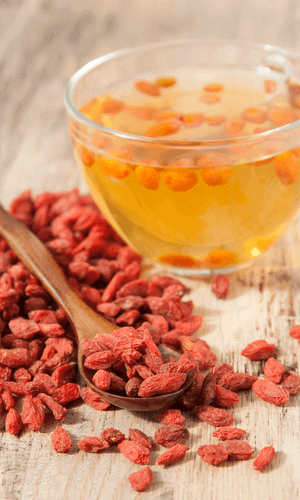
Eating Goji Plant Shoots and Leaves
young shoots and leaves are used in oriental cooking. they are harvested commercially as a leaf vegetable in Asia. leaves can be left on shoots and the entire piece can be used for a vegetable or dried for later use.
“Vegetables unique to the Asian market” include the Chinese Goji Berry (Lycium chinense). another study cites that leaves of the Red Goji Berry (Lycium barbarum) are widely used as medicine vegetables and functional tea in China.
Eating Goji Berry SHOOTS
My urban homestead offered the only thoughtful explanation of how shoots are eaten.
My favorite part of the plant is the young shoots that come up in places where I don’t want them, so I can pick them and eat them. Please note that the shoots are only edible when they are young, tender, and snap cleanly off as soon as you try to bend them. If they will bend without snapping, they are not fit to eat. I chop a bundle of shoots into fine cross section, about 1/4” lengths, and stirfry with some garlic, ginger, and soy, and find them very good. If the stems are getting wiry and bendable, you can still harvest the leaves and add them to mixed greens or cook them lightly in a Thai-style curry.
Eating Goji Berry LEAVES
leaves of Lycium barbarum, called “tianjingcao” (vitality and vigor of the nature) are used in traditional Chinese medicine, have been rarely studied, despite their use in alleviating mineral deficiency, combating heat distress, quenching thirst, dispelling wind, and enhancing eyesight (Functional constituents of wild and cultivated Goji (L. barbarum L.) leaves: phytochemical characterization, biological profile, and computational studies).
leaves have also been widely used as tea, medicinal vegetables, and herbal drugs in China, Southeast Asia, and are nowadays highly emphasized in Europe and North America as a functional tea or in dietary supplements. tender leaves have been used to cook soup, or consumed stir-fried, and with boiled eggs in many Asian countries (Ibid).

Goji Berry Health Benefits
1, 2 HEPPY cannot take any responsibility for any adverse effects from the use of plants. Always seek advice from a professional before using a plant for food or medicinally. This information is intended for educational purposes only and should not be considered as a recommendation or an endorsement of any particular medical or health treatment.
traditional Chinese medicine uses Goji root bark (Digupi) and the fruit (Gouqizi). the leaves and the seeds are also mentioned in a few medicinal books. only Lycium barbarum is cited in the Pharmacopoeia of the People’s Republic of China; however, L. barbarum and L. chinense, have been used for more than 2000 years in the traditional Chinese Medicine. early records trace back to the Tang Dynasty (1000–1400 AD). Goji Berry is also part of the medicinal tradition in Vietnam, Korea and Japan.
however, the nutritional and bioactive properties of Goji Berry “largely” depends on the species. also, the bioactive compounds in Goji Berry are affected by geographic origin, harvest time, and post-harvesting factors.
- Black Goji Berry (Lycium ruthenicum) extract has the highest total phenolic content, and the best antioxidant activity (anti-cancer, anti-inflammatory benefits).
- Chinese Goji Berry (Lycium chinense) [very difficult to find definitive, credible information; I have to circle back to reading research]
- Golden Goji Berry (Lycium barbarum) have high levels of flavonoids and pronounced antimicrobial properties.
- Red Goji Berry (Lycium barbarum) are predominant in total Vitamin C and carotenoid (Beta carotene [Vitamin A], lycopene and more).
Goji Berry benefits include Flavonoids. flavonoids have antioxidant, antiviral, antitumor, antibacterial, and cholesterol-lowering (hypolipidemic) qualities. More bioactive compounds to be listed!!
word of CAUTION: Goji Berry Health Benefits FRAUD
i’m including this warning out of respect to my readers. Goji Berry benefits have been overstated. studies about Goji’s benefits have been “extrapolated out of context” (Dr. Stephen Sagar, Professor & Oncologist).
1. CBC News investigative report, “Getting Juiced”. the report shows the hype and how a Goji products were sold through a pyramid scheme by FreeLife International, Inc. FreeLife representative “Dr.” Earl Mindell claimed the Memorial Sloan-Kettering Cancer Center in New York had completed clinical studies showing that use of Goji Berry juice would prevent 75% of human breast cancer cases.
His “Ph.D.” was obtained in 1985 from Pacific Western University, a nonaccredited correspondence school that has no recognized scientific standing. His herbalist diploma was obtained in 1995 from nonaccredited Dominion Herbal College.
a class action lawsuit was filed against FreeLife
2. Since the early 21st century, high levels of insecticide residues (including fenvalerate, cypermethrin, and acetamiprid) and fungicide residues (such as triadimenol and isoprothiolane), have been detected by the United States Food and Drug Administration in some imported wolfberries and wolfberry products of Chinese origin, leading to the seizure of these products.[32]
3. sun drying. This topic will take more time to research — need to describe a simple process for the reader. There’s several sun drying techniques!
4. according to the Division of Pharmaceutical Biology, University of Basel in Switzerland (2009), “…there are at the moment no scientific evidences to sustain the claims made for Goji juice as a ‘cure-all’ or a miraculous drink for well-being and longevity.”
HEPPY™ is a NO bull$#it operation. as such, we want YOU to know that claims of Goji Berry benefits have been abused. be an INFORMED consumer.
you TOO would be cautious if your read scientific reports for three weeks (3 weeks just dedication to Goji).
Black Goji Berry benefits
Black Goji (Lycium ruthenicum) “have gradually become a research hotspot due to their prominent antioxidant, hypolipidemic [cholesterol-lowering], hypoglycemic [low blood sugar regulating], anti-tumor, and immunity enhancing activities and their prevention of cardiovascular and cerebrovascular [blood flow to brain] diseases” (Characterization and Evaluation of Antioxidant and Anti-Inflammatory Activities of Flavonoids from the Fruits of Lycium barbarum).
Flavonoids are identified as the main phytochemical compounds in Lycium barbarum. thirteen flavonoids in Black Goji Berry were identified by liquid chromatography–mass spectrometry (LC–MS). in terms of antioxidant activity, Black Goji Berry showed a strong free radical scavenging ability (ibid).
another study found that Black Goji Berry tea is healthier than Red Goji Berry tea. Infused at 100° water for the same time, Black Goji has 5 times more antioxidant capacity and 2 times more polyphenols (micronutrients that naturally occur in plants) versus Red Goji Berry tea (Black goji berry (Lycium ruthenicum) tea has higher phytochemical contents and antioxidant properties than red goji berry tea).
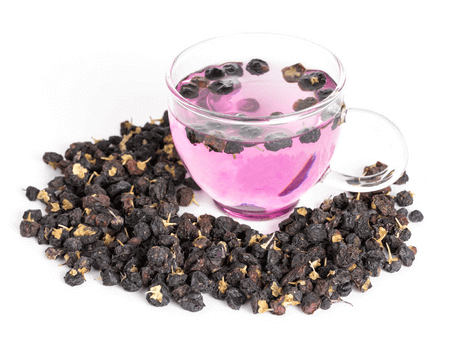
Chinese Goji Berry
Chinese Goji Berry (Lycium chinense) is a major Chinese tonic herb with a 2,000 year history of medicinal use. Lycium barbarum and Lycium chinense have been used interchangeably as food and medicine at least since 1,300 years. however, “for reasons which are not fully clear,” studies on Lycium chinense have focused on the roots and the leaves, rather than the fruit (Goji (Lycium barbarum and L. chinense): Phytochemistry, pharmacology and safety in the perspective of traditional uses and recent popularity). the same study found that “The composition of the fruit of L. chinense appears similar [to L. barbarum].”
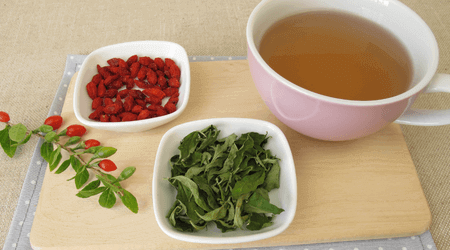
Golden & Red Goji Berry
Red Goji Berry (Lycium barbarum) is by far the most popular species of all Gojis. the Golden Goji (Lycium barbarum) was introduced in 2017 and there’s little research about benefits of eating Golden Goji Berries. the research below is on the Red Goji Berry (Lycium barbarum).
Commercial uses and opportunity
the marketing has been done for YOU! Goji Berry fruit is well known. in fact, the marketing of Goji may be excessive based on scientific literature and history of fraudulent claims. so please be a responsible seller. Goji IS a healthy fruit. however, it is NOT a cure-all and it DOES have risks.
Farmers' market or cottage food industry
ripe berries are edible, berries can be eaten fresh or dried, young shoots and leaves are used in oriental cooking, and berries are used to make an herbal tea. it has a nearly 2,000 year history of use in traditional Chinese medicine, and everyone knows the fruit as a ‘superfruit’ (HEPPY believes the Aronia Berry, Black Currant and Sea Berry are reliably better for us, and safer, btw).
Red Goji make up 90% of all commercially available goji berries. China is the main supplier but i cannot find clear data (eg, total pounds of Goji Berries grown; % grown in China). but is buying Red Goji from China the best option?
there is a LOT of opportunity for a niche market but NOT with the Red Gojis :). Black Goji and the Golden Goji Berries are scarce but easy to grow. also, they’re better!
- Black Goji are more expensive than Red Goji (10 times more, according to these folks).
- it IS likely that Black Goji has more polyphenols and antioxidant than Red Goji.
- Golden Goji are 15% more juicy with no bitterness when compared to Red Goji Berry.
- what’s the fruit quality like from Chinese (or North American) industrialized farms?
- sun drying is likely common method used in China to produce dry Goji Berry. however, a study about drying Black Goji Berry found that sun drying created the LOWEST quality fruit when compared to freeze drying or hot air drying.
potential products are FAR ranging. and I would argue that it’s a wonderful novelty fruit to make preserves or jams, and I’ve read that it can be baked into goods. or, sell fresh fruit.
Commercial or private landscaping
get out ahead and impress the clients! imagine planting a Black, Golden and Red Goji plants together? show initiative by planting a disease/pest-free plants while other commercial landscaping firms do not.
in particular, the Black Goji (Lycium ruthenicum) appears to be remarkably drought resistant. it is “highly suitable for combating soil desertification and alleviating soil salinity/alkalinity/pollution….“
Goji Berry: how to grow, train, prune, and harvest Gojis
Goji plants are easy-to-grow, shrub-like plants. they need very little care. other than picking fruit and pruning / fertilizing once-per-two years, the Goji plants growing at HEPPY™ are care-free — leave us alone — beautiful plants. we LOVE care-free plants 😉
Spacing Goji Plants
plant Goji plants as close as 2 feet apart (0.6 meters), or 6 to 8 feet apart (2 to 2.5 meters). spacing depends on YOUR landscape architecture / landscape design.
we grow Goji plants in clusters of 3 to 5 plants within 4 feet of each other. that’s our exhibition garden design. in one area, four plants are in a 5’x5′ square. alternatively, we have pairs in a row only 3 to 4 feet apart.
Soil, Fertilizer and Watering
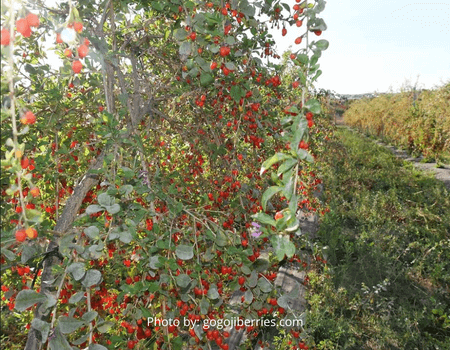
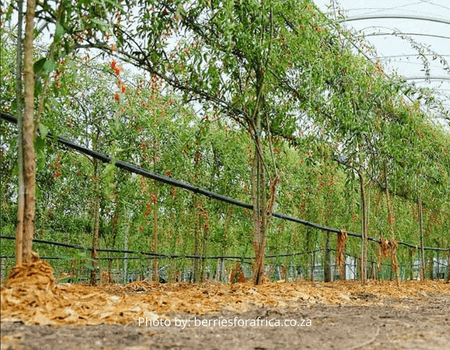
other than planting in well-drained soil, Goji Berry plants are largely care-free. they are tolerant of many soils, pest and disease free, easy to prune, and drought tolerant.
Soil: Goji Berry soil requirements
we grow Goji in rich organic soil; however, the Black Goji is so tolerant of poor soil that it is “highly suitable for combating soil desertification and alleviating soil salinity/alkalinity/pollution….” poor soil simply slows growth and decreases fruit production; rich soil will improve the plant’s qualities (growth, fruiting, visual appeal, etc.).
Fertilizer: Goji Berry fertilizer requirements
fertilize: Goji plants benefits from a good dose of nitrogen with phosphorus in early spring. Edible Landscape recommends “fast acting” nitrogen (typically, a more water-soluble nitrogen). over fertilize and you’ll have a lot of shoots to prune ;).
we fertilize our Goji plants in the Spring. we fertilize once-per-two years with standard, slow release 10-10-10 fertilizer. we fertilize moderately because the more we fertilize the more we need to prune.
Watering: how often to water Goji Berry plant
watering: only newly planted Goji need regular watering. overall, Goji are drought tolerant and require little water. the optimal climate is hot dry summers with cool nights. however, HEPPY™ grows Goji successfully in the stifling heat & humidity of Maryland, USA. wet soil and continuously moist soil is not the best choice for Goji.
in the spring we provide a deep watering (low & slow for 30 minutes). if the summer is dry, we deep water Gojis once, as fruit ripens.
Bearing fruit
Goji Berry plants bear fruit quickly. they bear fruit within 1 to 2 years after planting, and reach full production in 3 to 5 years.
Pruning Goji
step 1 is to determine if you’ll allow the plant to sprawl, trellis or as a single-stem plant. each of the three choices below increases the amount of time you’ll spend pruning.
Prune: no trellis / sprawling plants
when the Goji plant is dormant, prune it to 12 inches or shorter, fertilize well, and allow the plant to sprawl. they grow remarkably well as ground cover!
the new growth simply spreads across the ground. the growth will be vigorous and green (no woody canes). canes that will harden-off by late fall and become woody. if not pruned EACH dormant period, the woody canes become the often-photographed arching canes you see.
Prune: trellis Goji Berry plants
prune when dormant, and on-going pruning is needed during the growing season. below is an entire section on growing Goji plants by trellis.
Prune: single-stem plant
start by selecting the largest healthy stem for a main trunk. stake it well, so it’s supported vertically. then, prune away all other stems/canes growing from the base. you’ll have little to no fruit BUT, you’ve started the single stem structure.
then, top the plant at 4 to 5 feet. this will promote lateral growth. you will encourage a canopy structure. this is the end of year 1.
for year 2 when the plant is dormant: prune excess stems (dead or extraneous small stems). prune canopy stems to 2 feet. as the canopy develops during the growing season, tip-prune lateral branches growing too long. what’s too long? lateral stems are too long when grow awry. develop a canopy! 😉
on-going pruning is needed during the growing season. remove new shoots growing from the base of the plant (they can be used cooked as a vegetable). remove suckers from around the plant. transplant suckers or pot them for sale. our Goji plants sucker moderately. i read that in the right condition, suckering can be aggressive.
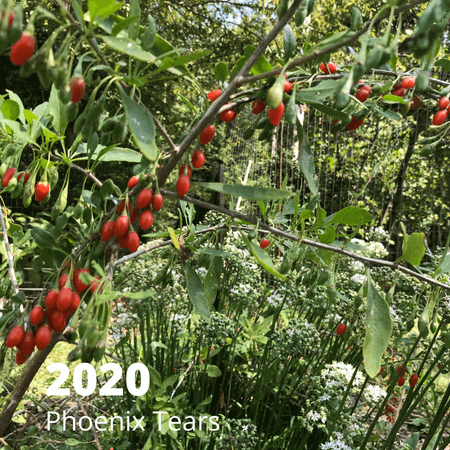

Goji Berry Pant Trellis
commercial growers use the Espalier trellis method, and grow Goji plants as a single stemmed plant.
single stem plant: see the section JUST above for the steps to develop a single stemmed Goji plant.
lateral growth: in the plant’s first and second year, select the most vigorous shoots — shoots that grow OFF OF the main trunk — and train them to grow on the trellis’ wire supports. these are called, cordons.
the require similar care to a trellising type of Blackberry. Gojis grow arching canes BUT do not and if you want the most fruit
Espalier Trellis
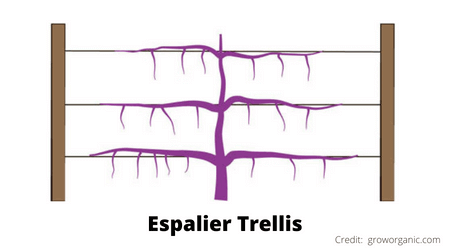
training Goji berry plants:
1. trellis system: we recommend the t-bar (overhead) or espalier (flat) trellises.
2. main trunk: in the plant’s first year, train ONE shoot as the main trunk. remove all other shoots from the base of the plant.
3. lateral growth (“Cordons”): in the plant’s first and second year, select the most vigorous shoots — shoots that grow OFF OF the main trunk — and train them to grow on the trellis’ wire supports. these are called, cordons.
the main stem will evolve into a trunk. the main trunk and lateral growth are the Goji plant’s structure. you will prune around them. shoots growing off the cordons are the source of your fruit! 😉
Harvesting Goji
picking fresh berries are easy to pick; however, NOT damaging the fruit while picking to the key. don’t ‘squish’ the fruit. squishing the fruit is somewhat easy. that will reduce the time it can be stored.
fresh Goji Berries have a SHORT shelf life. it lasts about 3 days fresh. BUT it can be frozen and freeze drying Goji Berry produces a far healthier food.
dried / dehydrated fruit is the most common commercial product but fresh fruit is easy to grow and healthier.
THE SECTION — Harvesting Goji — IS BEING RESEARCHED AND WRITTEN
This section to be completed soon :/
Propagate Goji Berry plants: cuttings, division, grafting, layering and seeding
propagate Goji Berry by division, seed, cuttings and possibly, layering. we propagate by division because it’s SO easy. the HEPPY™ way 😉
Propagate by DIVISION — Harvest Suckers
Goji plants “sucker” so propagation by division is a no-brainer.
Goji Roots Sucker
suckering is when plants’ spread roots undergrown AND within 2 feet or so, send-up new growth. not all plants sucker.
carefully dig-up the sucker — the roots WITH the above-ground growth. you literally get a new plant! now, it can be potted or transplanted. also, far less care is needed to develop a healthy, new plant. this propagation method is called division.

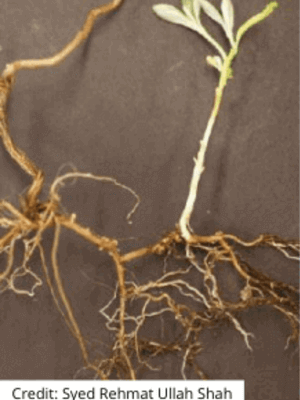
Propagate by Division
division is a vegetative propagation for plants that produce suckers, stolons, bulbs, tubers or rhizomes. propagate by division by digging up the plant and divide it carefully using a spade or secateurs. this method is the fastest and easiest way to get a mature plant!
OTHER Propagation Methods
Propagate by Seed
sow early spring in a greenhouse. germination is usually good and fairly quick. pick out the seedlings into individual pots when they are large enough to handle and grow them on in the greenhouse for their first winter. plant out in late spring or early summer. pinch out the shoot tips of the young plants in order to encourage bushy growth[78]. (Plants For A Future).
Propagate by Cuttings
cuttings of half-ripe wood, 5 – 10cm with a heel if possible, July/August in individual pots in a frame. good percentage survive[78]. cuttings of mature wood of the current season’s growth, autumn to late winter in a cold frame. high percentage survive[78, 200]. Division of suckers in late winter. (Plants For A Future).
Goji Berry growing at HEPPY™
propagate Goji Berry by division, seed, cuttings and possibly, layering. we propagate by division because it’s SO easy. the HEPPY™ way 😉
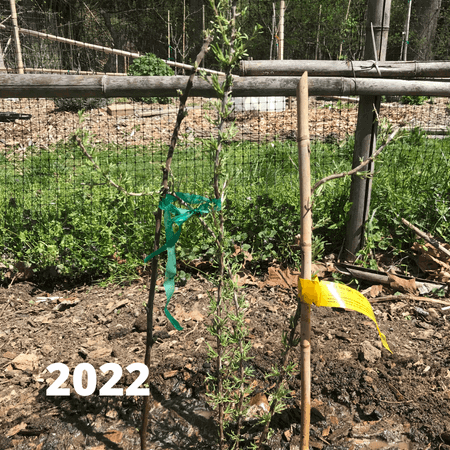
Black Goji Berry (Lycium ruthenicum)
we purchased three plants and BY FAR the best value was from Restoring Eden Nursery.
we purchased two outstanding specimens in 1gallon containers for $20.00 each.
they were planted in full sun, on a mound of our hand-mixed super-soil. however, i added a lot of sand.
we spaced our plants about 4 feet apart. our goal is to propagate this variety for sale! of course, enjoying the fruit too.
Black Goji Berry is a rather rare plant. in the right conditions, fills its branches FULL of fruit. so much fruit that you can’t see the branches! that’s an exotic look. people will ‘stop in their tracks’ when they see a healthy Lycium ruthenicum plant full of Goji Berries.
i suspect that the trellising will not be needed for Black Goji Berry. it’s branches are more stout than the Chinese Goji Berry (Lycium chinense) and Golden & Red (Lycium barbarum) Goji plants.
Chinese Goji Berry (Lycium chinense)
in 2022 we purchased two ‘seedlings’ from Planting Justice nursery. but when they arrived they were labeled, Lycium barbarum. my heart sank. long story short, they were Lycium barbarum and mislabeled online :((((
it is virtually IMPOSSIBLE to find a live Lycium chinense in the USA (i have the email proof of all my attempts to find live plants :(. as of June 2022).
the Chinese Goji (Lycium chinense) is the third of three fruiting Goji Berry plants. we want to grow all three so we can give our viewers a full story about what is what. to show how each species grows, and their strengths and weaknesses!
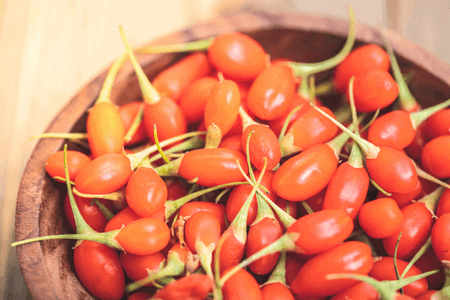
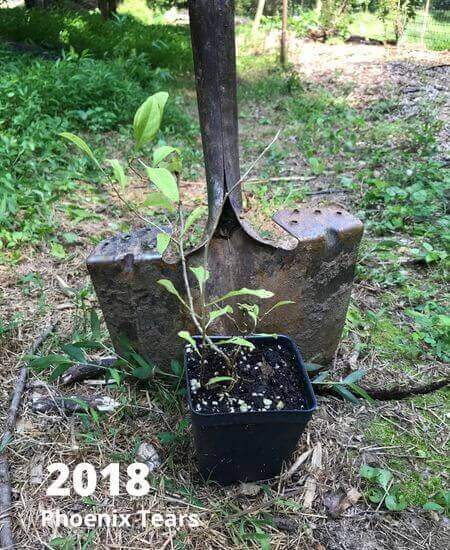
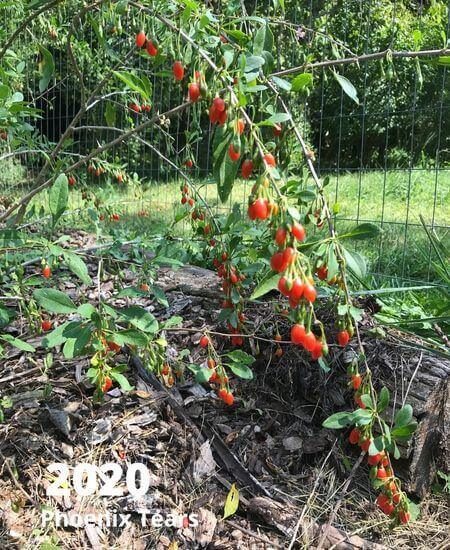

Golden & Red Goji Berry (Lycium barbarum)
Golden Goji Berry
we purchased three plants from One Green World. i tried to buy this plant for over a year! i pulled the trigger once they became available!
we purchased Golden Goji in 1gallon containers for $33.00 each! we WILL be selling these once they get going. also, i anticipate this will be our primary source of fresh fruit. it’s advertised as more juicy and with no bitterness, when compared to the Red Goji Berry.
Red Goji Berry
our Phoenix Tears Goji Berry were given to us for free! Peaceful Heritage Permaculture Fruit Nursery was so nice to do that. the twist — the plants were so little and not doing well at the nursery. two 4” pots, $free!
i had no idea what to expect & got the girls into our soil (late 2018). well, then they grew, and grew and grew! they have suckered and we have Phoenix Tears Goji Berry in several locations. additional Goji plants will be propagated by division and sold!




